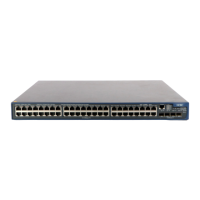2-10
z Before adding an alarm entry, you need to use the rmon event command to define the events to be
referenced by the alarm entry.
z Make sure the node to be monitored exists before executing the rmon alarm command.
Examples
# Add the alarm entry numbered 1 as follows:
z The node to be monitored: 1.3.6.1.2.1.16.1.1.1.4.1
z Sampling interval: 10 seconds
z Upper threshold: 50
z The event-entry1 argument identifies event 1.
z Lower threshold: 5
z The event-entry2 argument identifies event 2
z Owner: user1.
<Sysname> system-view
System View: return to User View with Ctrl+Z.
[Sysname] interface Ethernet 1/0/1
[Sysname-Ethernet1/0/1] rmon statistics 1
[Sysname-Ethernet1/0/1] quit
[Sysname] rmon event 1 log
[Sysname] rmon event 2 none
[Sysname] rmon alarm 1 1.3.6.1.2.1.16.1.1.1.4.1 10 absolute rising_threshold 50 1
falling_threshold 5 2 owner user1
# Remove the alarm entry numbered 15 from the alarm table.
[Sysname] undo rmon alarm 15
rmon event
Syntax
rmon event event-entry [ description string ] { log | trap trap-community | log-trap log-trapcommunity
| none } [ owner text ]
undo rmon event event-entry
View
System view
Parameters
event-entry: Event entry index, in the range of 1 to 65535.
description string: Specifies the event description, a string of 1 to 127 characters.
log: Logs events.
trap: Sends traps to the NMS.
trap-community: Community name of the NMS that receives the traps, a string of 1 to 127 characters.

